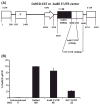E47 retroviral rescue of intrinsic B-cell defects in senescent mice
- PMID: 21241451
- PMCID: PMC4710514
- DOI: 10.1111/j.1474-9726.2011.00673.x
E47 retroviral rescue of intrinsic B-cell defects in senescent mice
Abstract
In aging, immune responses are dramatically impaired, specifically the ability to produce protective antibodies. We previously showed that with age there is a B-cell intrinsic decrease in class switch recombination (CSR) because of a decrease in activation-induced cytidine deaminase (AID). One mechanism we have demonstrated for decreased AID includes increased mRNA degradation of the transcription factor E47, critical for AID transcription. Here, we show by means of a retroviral construct containing the DsRED reporter and the 3'UTR of E47 that the 3'UTR lowers mRNA expression, and particularly in B cells from old mice. This is the first demonstration that the E47 3'UTR directly regulates its degradation. The AID mRNA was not differentially regulated by degradation in aging. Therefore, we have here further established critical components for decreased AID with age. The major aim of this study was to establish conditions for the rescue of the intrinsic defect of aged B cells with retroviral addition of the coding region of E47 in splenic B cells to restore their ability to produce optimal AID and class switch to IgG. In this study, we show that young and old primary B cells overexpressing a stable E47 mRNA up-regulate E47, AID, and CSR and improve B-cell immune responses in senescent murine B cells. Our results provide a proof of principle for the rescue of intrinsic B-cell defects and the humoral immune response in senescence.
© 2011 The Authors. Aging Cell © 2011 Blackwell Publishing Ltd/Anatomical Society of Great Britain and Ireland.
Figures







Similar articles
-
MicroRNAs miR-155 and miR-16 Decrease AID and E47 in B Cells from Elderly Individuals.J Immunol. 2015 Sep 1;195(5):2134-40. doi: 10.4049/jimmunol.1500520. Epub 2015 Jul 29. J Immunol. 2015. PMID: 26223652 Free PMC article.
-
Aging murine B cells have decreased class switch induced by anti-CD40 or BAFF.Exp Gerontol. 2007 Mar;42(3):192-203. doi: 10.1016/j.exger.2006.09.003. Epub 2006 Oct 25. Exp Gerontol. 2007. PMID: 17067770 Free PMC article.
-
Aging down-regulates the transcription factor E2A, activation-induced cytidine deaminase, and Ig class switch in human B cells.J Immunol. 2008 Apr 15;180(8):5283-90. doi: 10.4049/jimmunol.180.8.5283. J Immunol. 2008. PMID: 18390709
-
Effects of aging on B cell function.Curr Opin Immunol. 2009 Aug;21(4):425-30. doi: 10.1016/j.coi.2009.06.001. Epub 2009 Jul 14. Curr Opin Immunol. 2009. PMID: 19608393 Free PMC article. Review.
-
Effect of age on the immunoglobulin class switch.Crit Rev Immunol. 2004;24(5):297-320. doi: 10.1615/critrevimmunol.v24.i5.10. Crit Rev Immunol. 2004. PMID: 15663361 Review.
Cited by
-
Aging impairs murine B cell differentiation and function in primary and secondary lymphoid tissues.Aging Dis. 2011 Oct;2(5):361-73. Epub 2011 Oct 28. Aging Dis. 2011. PMID: 22396888 Free PMC article.
-
Ageing-related bone and immunity changes: insights into the complex interplay between the skeleton and the immune system.Bone Res. 2024 Aug 5;12(1):42. doi: 10.1038/s41413-024-00346-4. Bone Res. 2024. PMID: 39103328 Free PMC article. Review.
-
Aging and neoteny in the B lineage.Blood. 2012 Nov 15;120(20):4143-9. doi: 10.1182/blood-2012-07-444711. Epub 2012 Aug 30. Blood. 2012. PMID: 22936664 Free PMC article. Review.
-
Age effects on mouse and human B cells.Immunol Res. 2013 Dec;57(1-3):354-60. doi: 10.1007/s12026-013-8440-9. Immunol Res. 2013. PMID: 24203437 Free PMC article. Review.
-
MicroRNAs miR-155 and miR-16 Decrease AID and E47 in B Cells from Elderly Individuals.J Immunol. 2015 Sep 1;195(5):2134-40. doi: 10.4049/jimmunol.1500520. Epub 2015 Jul 29. J Immunol. 2015. PMID: 26223652 Free PMC article.
References
-
- Asanuma H, Hirokawa K, Uchiyama M, Suzuki Y, Aizawa C, Kurata T, Sata T, Tamura S. Immune responses and protection in different strains of aged mice immunized intranasally with an adjuvant-combined influenza vaccine. Vaccine. 2001;19:3981–3989. - PubMed
-
- Diaz M, Storb U. A novel cytidine deaminase AIDs in the delivery of error-prone polymerases to immunoglobulin genes. DNA Repair (Amst) 2003;2:623–627. - PubMed
-
- Dorshkind K, Montecino-Rodriguez E, Signer RA. The ageing immune system: is it ever too old to become young again? Nat Rev Immunol. 2009;9:57–62. - PubMed
-
- Ephrussi A, Church GM, Tonegawa S, Gilbert W. B lineage – specific interactions of an immunoglobulin enhancer with cellular factors in vivo. Science. 1985;227:134–140. - PubMed
Publication types
MeSH terms
Substances
Grants and funding
LinkOut - more resources
Full Text Sources
Medical

